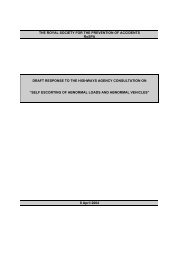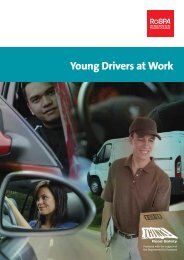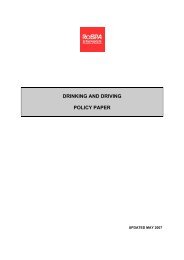RoSPA Road Safety
RoSPA Road Safety
RoSPA Road Safety
You also want an ePaper? Increase the reach of your titles
YUMPU automatically turns print PDFs into web optimized ePapers that Google loves.
<strong>RoSPA</strong>‟s <strong>Road</strong> <strong>Safety</strong> Work<br />
August 2009<br />
INTRODUCTION<br />
<strong>RoSPA</strong> is an independent, registered charity which was created in 1917 in response to an<br />
'alarming increase in traffic accidents‟ in London. Today, <strong>RoSPA</strong> promotes safety in all areas<br />
of life – on the road, in the home, at work, in schools, at leisure and on or near water. Our<br />
aim is to Save Lives and Reduce Injuries.<br />
The breadth of <strong>RoSPA</strong>‟s expertise allows us to draw lessons from different areas, schools of<br />
thought and approaches to injury prevention. Indeed, this is how <strong>RoSPA</strong> began its Managing<br />
Occupational <strong>Road</strong> Risk campaign in 1996, which has led to „at-work road safety‟ being a<br />
key priority in the UK‟s road safety strategy today. Other examples of <strong>RoSPA</strong>‟s contribution<br />
to road safety over the years include the formation of a national network of local road safety<br />
committees (the forerunner of today‟s local authority road safety officer service), the National<br />
Cycling Proficiency Scheme, the Tufty Club, compulsory seat belt wearing (<strong>RoSPA</strong>‟s<br />
President introduced an amendment to the Transport Bill in 1981), and the ban on using a<br />
hand-held mobile phone while driving.<br />
<strong>Safety</strong> organisations can be accused of taking safety problems too seriously and<br />
encouraging „hypersafety‟, „excessive risk aversion‟ and the „nanny state‟. However,<br />
“Absolute safety” is neither feasible nor desirable, since it would come at such cost to our<br />
freedoms. Common sense and balance is essential when developing and promoting safety<br />
interventions. There are clearly areas where prescription, through regulation, legislation or<br />
standards, is essential, for example, the nuclear, chemical or aviation industries. On the<br />
other hand, people need to be able to get on with their lives and be free to decide what risks<br />
they wish to take, provided they are not putting others in danger.<br />
The difficulty is where to draw the line - too prescriptive, and accusations of the “nanny state”<br />
fly around; too casual and people would undoubtedly be forced to take unknowing risks.<br />
<strong>RoSPA</strong> draws the line with two simple questions:<br />
1) Is the intervention proportionate to the risk? If the<br />
problem is not that great, steer towards the lighter<br />
touch, but if the evidence demands more<br />
guidance, consider intervention.<br />
2) What would be the effect on others? Someone<br />
who puts only themselves at risk should have the<br />
freedom to do so; but if an act can kill or injure<br />
others, it must be proscribed or regulated. A solo<br />
mountain climber fits into the first category; a<br />
speeding motorist the second.<br />
<strong>RoSPA</strong>‟s Approach to <strong>Safety</strong> is discussed in further detail in our Chief Executive‟s Report for<br />
the 2007/08 Annual Review and at www.rospa.com/aboutrospa/rospa_safetypoints.htm.<br />
1
















